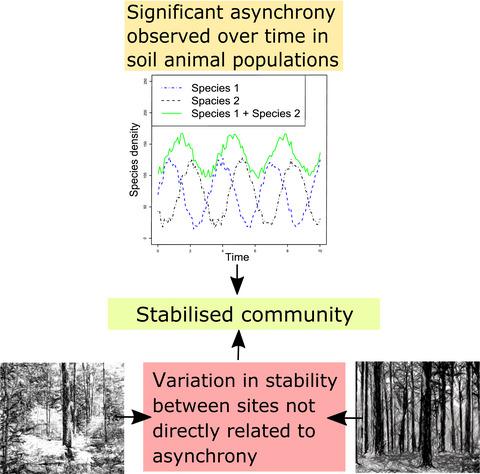当前位置:
X-MOL 学术
›
J. Anim. Ecol.
›
论文详情
Our official English website, www.x-mol.net, welcomes your feedback! (Note: you will need to create a separate account there.)
Population asynchrony alone does not explain stability in species rich soil animal assemblages: the stabilising role of forest age on oribatid mite communities
Journal of Animal Ecology ( IF 4.8 ) Pub Date : 2020-03-09 , DOI: 10.1111/1365-2656.13203 Tancredi Caruso 1 , Viesturs Melecis 2 , Ugis Kagainis 2 , Tom Bolger 1
Journal of Animal Ecology ( IF 4.8 ) Pub Date : 2020-03-09 , DOI: 10.1111/1365-2656.13203 Tancredi Caruso 1 , Viesturs Melecis 2 , Ugis Kagainis 2 , Tom Bolger 1
Affiliation

|
The importance of microbial and plant communities in the control of the diversity and structure of soil animal communities has been clarified over the last decade. Previous research focused on abiotic factors, niche separation and spatial patterns. Significant gaps still exist in our knowledge of the factors that control the stability of these communities over time. We analysed a nine-year data set form the national Long-term Ecological Research Network of Latvia. We focused on 117 oribatid species from three Scots pine forests of different age (<40 yrs, 65 yrs, and >150 yrs) and structure. For each forest type, 100 samples were collected each year, providing very high replication and long time series for a soil community. We assessed different aspects of stability: we used a dynamic null model, parametrised on observed growth rates, to test the hypothesis that asynchrony in species populations stabilises total community size; we also analysed alpha and beta diversity over time to test the hypothesis that temporal variation in species composition and relative abundances is controlled by forest attributes. Real communities can be more stable than their stochastic counterparts if species are asynchronous, confirming for the first time the role of asynchrony in stabilising soil communities. Yet, while some real communities were more stable and had higher abundance and growth rates than others, they were not necessarily more asynchronous than the less stable communities. Species composition and relative abundances were also less variable in the more stable communities. Species asynchrony generally stabilises species rich communities but is not sufficient to explain different levels of stability between forests. Forest age is a key factor explaining different levels of overyielding and so stability. Data suggests that both asynchrony and high diversity of microhabitat structure of Scots pine forests promote stability of soil animal communities.
中文翻译:

单独的种群不同步并不能解释物种丰富的土壤动物组合的稳定性:森林年龄对 oribatid 螨群落的稳定作用
微生物和植物群落在控制土壤动物群落多样性和结构方面的重要性在过去十年中得到了阐明。以前的研究集中在非生物因素、生态位分离和空间模式。随着时间的推移,我们对控制这些社区稳定性的因素的了解仍然存在重大差距。我们分析了来自拉脱维亚国家长期生态研究网络的九年数据集。我们专注于来自三个不同年龄(<40 年、65 年和 >150 年)和结构的苏格兰松林的 117 种 oribatid 物种。对于每种森林类型,每年收集 100 个样本,为土壤群落提供了非常高的重复性和较长的时间序列。我们评估了稳定性的不同方面:我们使用了动态零模型,以观察到的增长率为参数,检验物种种群的不同步性稳定总群落大小的假设;我们还分析了 alpha 和 beta 多样性随时间的变化,以检验物种组成和相对丰度的时间变化受森林属性控制的假设。如果物种是异步的,那么真实的群落可能比随机的群落更稳定,这首次证实了异步在稳定土壤群落中的作用。然而,虽然一些真实社区比其他社区更稳定,拥有更高的丰度和增长率,但它们并不一定比不稳定的社区更不同步。在更稳定的群落中,物种组成和相对丰度的变化也较小。物种不同步通常可以稳定物种丰富的群落,但不足以解释森林之间不同程度的稳定性。林龄是解释不同程度的超产和稳定性的关键因素。数据表明,苏格兰松林微生境结构的不同步性和高度多样性促进了土壤动物群落的稳定性。
更新日期:2020-03-09
中文翻译:

单独的种群不同步并不能解释物种丰富的土壤动物组合的稳定性:森林年龄对 oribatid 螨群落的稳定作用
微生物和植物群落在控制土壤动物群落多样性和结构方面的重要性在过去十年中得到了阐明。以前的研究集中在非生物因素、生态位分离和空间模式。随着时间的推移,我们对控制这些社区稳定性的因素的了解仍然存在重大差距。我们分析了来自拉脱维亚国家长期生态研究网络的九年数据集。我们专注于来自三个不同年龄(<40 年、65 年和 >150 年)和结构的苏格兰松林的 117 种 oribatid 物种。对于每种森林类型,每年收集 100 个样本,为土壤群落提供了非常高的重复性和较长的时间序列。我们评估了稳定性的不同方面:我们使用了动态零模型,以观察到的增长率为参数,检验物种种群的不同步性稳定总群落大小的假设;我们还分析了 alpha 和 beta 多样性随时间的变化,以检验物种组成和相对丰度的时间变化受森林属性控制的假设。如果物种是异步的,那么真实的群落可能比随机的群落更稳定,这首次证实了异步在稳定土壤群落中的作用。然而,虽然一些真实社区比其他社区更稳定,拥有更高的丰度和增长率,但它们并不一定比不稳定的社区更不同步。在更稳定的群落中,物种组成和相对丰度的变化也较小。物种不同步通常可以稳定物种丰富的群落,但不足以解释森林之间不同程度的稳定性。林龄是解释不同程度的超产和稳定性的关键因素。数据表明,苏格兰松林微生境结构的不同步性和高度多样性促进了土壤动物群落的稳定性。



























 京公网安备 11010802027423号
京公网安备 11010802027423号